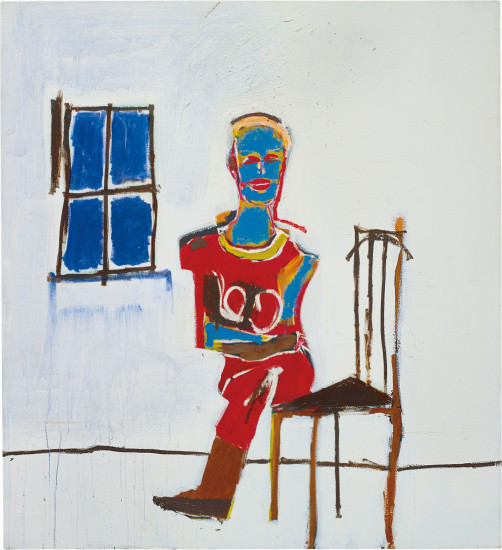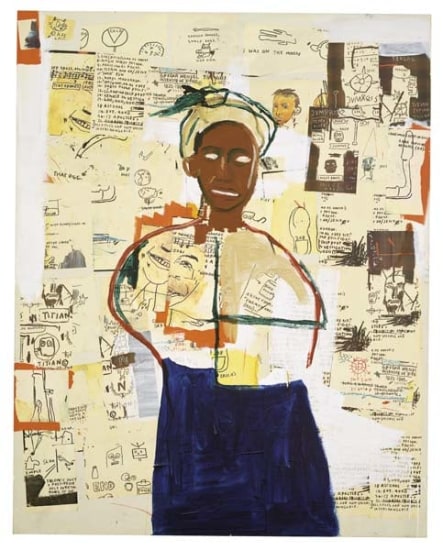PROPERTY FROM A PRIVATE SWISS COLLECTION Jean-Michel-Basquiat Overrun 1985 Oil, acrylic and metallic paint with colour photocopy collage laid on wooden panel. 203 × 81 cm (80 × 31 7/8 in). Signed, titled and dated 'Basquiat Overrun 1985' on the reverse. This work is accompanied by a certificate of authenticity issued by the Estate of Jean-Michel-Basquiat.
Provenance Mary Boone Gallery, New York; Galerie Beaubourg, Paris Catalogue Essay Jean-Michel-Basquiat's story is well known: the epitome of the artist-rebel who, from impoverished immigrant beginnings and living on the streets of New York City, had a meteoric rise to the top of the art world only to fall even faster and harder, consumed by a debilitating drug habit and haunted by doubts. Like many of history's artistic outsiders – Vincent van Gogh and Paul Gauguin come to mind – Basquiat died never having really belonged but also not without leaving behind a brilliant and consequential body of work. In just eight brief years, Basquiat displayed an exceptional ability to execute paintings loaded on the one hand with the immediacy of attitude and turmoil, while on the other dealing poignantly with profound human questions of life and death. Executed in 1985 at the height of Basquiat's powers, Overrun is a frantic, powerful canvas which features some of the most important themes found throughout the artist's work. For example, the most striking and immediately recognizable motif in the painting is the beautifully rendered, raw, expressionist figure found in the lower half of the composition. Part-human, part-animal, Basquiat's anthropomorphic creature displays an aggression and anger with its stern eyes and gaping mouth. These tormented heads have often been interpreted as self-portraits, a reflection, it has been suggested, of the artist's struggle as an African American in a predominantly white art world. The haunting, ghost-like figure with its hollow eyes, recalls African tribal masks and voodoo ritual figurines used throughout the African-American community in the Southern United States and in the former slave colonies of the Caribbean. Being of Haitian origin, Basquiat throughout his career incorporated Black history into his works, but from this mid-point in his career, an obsession with mortality also permeates his art, to the point where his final work is apocalyptically titled Riding with Death. In a manner similar to the French painter Jean Dubuffet Overrun's heavily vertical format and its five black window frames at the top are suggestive of a vibrant urban landscape. Basquiat was greatly influenced by the high-rise skyscrapers of his native New York City and continuously referenced it. His teenage years spent as a wandering homeless artist, during which time he tagged mysterious and witty statements under the pseudonym SAMO, left a lasting impression. Art historians have long drawn comparisons with Jean Dubuffet's childlike and naïve style and his lack of interest in rationally coherent compositions with a central perspective – a comparison most striking when comparing Dubuffet's series Views of Paris with Overrun. Like Basquiat, Dubuffet made graffiti the central motif of his art. Another important feature to be seen here, and which can be seen elsewhere in Basquiat's output, is the use of language, in the form of consciously child-like scribbles and cryptic writings. While painting in the basement of Annina Nosei's gallery, Basquiat had a book open to pages illustrating Twombly's large, lyrical compositions which incorporate text and image. While recalling similar inscriptions in the works of Jean Dubuffet and Cy Twombly Basquiat's words, whether crossed out, repeated, or naively spelled, signify both the urgency and power with which he could communicate through his art. Paradoxically, this was an ability he so cruelly lacked in the real world so it is all the more affecting when seen in his paintings. On Basquiat's exceptionally personal, self-reflective and vulnerable approach, the artist's early dealer Tony Shafrazi has said, "his use of text is too deeply hermetic and coded to be directed to a particular class in a glib or knowing fashion. Since his scrawls are often auto-biographical in nature, and chronicle a tumultuous personal life and journey, they are possessed of a more unconscious desire to confess
PROPERTY FROM A PRIVATE SWISS COLLECTION Jean-Michel-Basquiat Overrun 1985 Oil, acrylic and metallic paint with colour photocopy collage laid on wooden panel. 203 × 81 cm (80 × 31 7/8 in). Signed, titled and dated 'Basquiat Overrun 1985' on the reverse. This work is accompanied by a certificate of authenticity issued by the Estate of Jean-Michel-Basquiat.
Provenance Mary Boone Gallery, New York; Galerie Beaubourg, Paris Catalogue Essay Jean-Michel-Basquiat's story is well known: the epitome of the artist-rebel who, from impoverished immigrant beginnings and living on the streets of New York City, had a meteoric rise to the top of the art world only to fall even faster and harder, consumed by a debilitating drug habit and haunted by doubts. Like many of history's artistic outsiders – Vincent van Gogh and Paul Gauguin come to mind – Basquiat died never having really belonged but also not without leaving behind a brilliant and consequential body of work. In just eight brief years, Basquiat displayed an exceptional ability to execute paintings loaded on the one hand with the immediacy of attitude and turmoil, while on the other dealing poignantly with profound human questions of life and death. Executed in 1985 at the height of Basquiat's powers, Overrun is a frantic, powerful canvas which features some of the most important themes found throughout the artist's work. For example, the most striking and immediately recognizable motif in the painting is the beautifully rendered, raw, expressionist figure found in the lower half of the composition. Part-human, part-animal, Basquiat's anthropomorphic creature displays an aggression and anger with its stern eyes and gaping mouth. These tormented heads have often been interpreted as self-portraits, a reflection, it has been suggested, of the artist's struggle as an African American in a predominantly white art world. The haunting, ghost-like figure with its hollow eyes, recalls African tribal masks and voodoo ritual figurines used throughout the African-American community in the Southern United States and in the former slave colonies of the Caribbean. Being of Haitian origin, Basquiat throughout his career incorporated Black history into his works, but from this mid-point in his career, an obsession with mortality also permeates his art, to the point where his final work is apocalyptically titled Riding with Death. In a manner similar to the French painter Jean Dubuffet Overrun's heavily vertical format and its five black window frames at the top are suggestive of a vibrant urban landscape. Basquiat was greatly influenced by the high-rise skyscrapers of his native New York City and continuously referenced it. His teenage years spent as a wandering homeless artist, during which time he tagged mysterious and witty statements under the pseudonym SAMO, left a lasting impression. Art historians have long drawn comparisons with Jean Dubuffet's childlike and naïve style and his lack of interest in rationally coherent compositions with a central perspective – a comparison most striking when comparing Dubuffet's series Views of Paris with Overrun. Like Basquiat, Dubuffet made graffiti the central motif of his art. Another important feature to be seen here, and which can be seen elsewhere in Basquiat's output, is the use of language, in the form of consciously child-like scribbles and cryptic writings. While painting in the basement of Annina Nosei's gallery, Basquiat had a book open to pages illustrating Twombly's large, lyrical compositions which incorporate text and image. While recalling similar inscriptions in the works of Jean Dubuffet and Cy Twombly Basquiat's words, whether crossed out, repeated, or naively spelled, signify both the urgency and power with which he could communicate through his art. Paradoxically, this was an ability he so cruelly lacked in the real world so it is all the more affecting when seen in his paintings. On Basquiat's exceptionally personal, self-reflective and vulnerable approach, the artist's early dealer Tony Shafrazi has said, "his use of text is too deeply hermetic and coded to be directed to a particular class in a glib or knowing fashion. Since his scrawls are often auto-biographical in nature, and chronicle a tumultuous personal life and journey, they are possessed of a more unconscious desire to confess

.jpg)









Try LotSearch and its premium features for 7 days - without any costs!
Be notified automatically about new items in upcoming auctions.
Create an alert